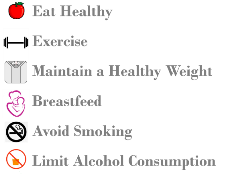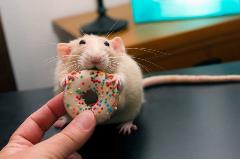
Breast cancer affects 1 in 8 women in the United States and is the leading female cancer globally.1,2 Although death rates have decreased since the 1980’s, incidences of breast cancer remain steady in women under 50.3 Screenings and early detection through mammograms and lab tests are believed to be partially responsible for the decrease in cancer deaths. Improved treatment options have also played a large role. Researchers continue to make great strides in understanding the causes and risks associated with breast cancer, leading to groundbreaking treatments. Hormone therapy, targeted therapy, tyrosine kinase inhibitors (TKIs) and immunotherapies are giving breast cancer patients a greater chance of recovery and increasing their life expectancy.
GET SCREENED REDUCE YOUR RISK


Further Research Needed
While improved treatment options have increased survival rates, doctors are seeing late effects from cancer treatments. Late effects are side effects that appear after treatment has ended and can range from acute to chronic and from mild to life threatening. The most common late effects are fatigue, digestion issues, sleep disturbances, heart disease, hormone changes, osteoporosis, and peripheral neuropathy. Additional research is needed to understand how to effectively prevent and treat late effects and improve quality of life for patients post cancer treatment.
DSI Serves Cancer Researchers
DSI solutions provide preclinical researchers tools to collect and report reliable, whole animal physiologic data, providing better understanding of the effects cancer and associated treatments have on the entire body. Using implantable telemetry, researchers can monitor animals wirelessly in vivo, reducing handling and decreasing stress. Decreased animal stress results in cleaner, more accurate data and improved animal welfare.
DSI offers the widest range of physiologic signal monitoring options including, but not limited to, blood pressure, tissue pressure, bone pressure, heart rate, respiratory rate, artery pressure, ventricular pressures, continuous glucose, electrocardiogram (ECG), electroencephalogram (EEG), electromyogram (EMG), electrooculogram (EOG), core and subcutaneous temperature, and activity.
Sleep

Doctors discovered breast cancer patients with altered sleep states experience decreased quality of life and typically have worse prognoses. The following study investigated tumor induced sleep, metabolism and immune changes in tumor-bearing mice with non-metastatic breast cancer.
A Role for Hypocretin/Orexin in Metabolic and Sleep Abnormalities in a Mouse Model of Non-metastatic Breast Cancer
Researchers used DSI’s PhysioTel® F20-EET telemetry to monitor EEG and EMG. Their goal was to analyze the homeostatic response to sleep deprivation during tumor development. Raw data was filtered and analyzed every 10 seconds with DSI’s sleep scoring software, Neuroscore.4 The study showed later stages of tumor development resulted in increased fragmented sleep in tumor bearing mice. In addition, the mice experienced altered temporal patterns of non-rapid eye movement (NREM) delta power. Fatigue was also present, indicated by reductions in locomotor activity and changes in body temperature regulation.4 Additional tests were completed to monitor tumor effects on metabolism and inflammatory markers, such as interleukin 6 (IL-6).
Results indicate tumors in the periphery, like those in non-metastatic breast cancer, alter sleep, metabolism, and inflammation due to aberrant activity of hypocretin/orexin neurons. This is caused by the deregulation of satiety hormones, those which regulate energy balance in the body.4
Visit our oncology circadian rhythm page to learn more about monitoring sleep in animal models.
Citation:
Borniger, J. C., Ii, W. H., S., Emmer, K. M., Zhang, N., Zalenski, Muscarella SL, Fitzgerald JA, Smith AN, Braam CJ, TinKai T, Magalang UJ, Lustberg MB, Nelson RJ3Devries, AC. (2018). “A Role for Hypocretin/Orexin in Metabolic and Sleep Abnormalities in a Mouse Model of Non-metastatic Breast Cancer”. Cell Metabolism, 28(1). https://doi.org/10.1016/j.cmet.2018.04.021
Glucose Metabolism

Researchers uncovered a correlation between high blood glucose and tumor malignancy. Since then, studies to better understand the role diet and type 2 diabetes might play in activating or promoting tumor cell growth have grown in popularity. In addition, cancer treatments have been shown to alter the way humans metabolize glucose, causing induced hyperglycemia and autoimmune type 1 diabetes. In the study below, researchers used continuous glucose telemetry to optimize the dosing schedule of a selective inhibitor which induced hyperglycemia.
Abstract 3933: Circadian Timing Regimen for Alpelisib (NVP-BYL719), a Selective Inhibitor of the Class Ia PI3K Isoform Alpha to Maximize Therapeutic Index
As clinical studies had indicated selective inhibitor BYL719 induced hyperglycemia, the research team decided to replicate this in an animal model and investigate. They implanted tumor bearing rats with DSI’s continuous glucose telemetry and discovered diurnal rhythms of glucose are highly reproducible over time. They also discovered leveling the dosing of BYL719 correlated with better control of glycaemia, leading to increased clinical translatability. 5
As 85% of oncology drugs fail in clinical trials due to a poor prediction of safety, more translatable methods are needed.5 DSI’s continuous glucose telemetry provides researchers reliable, stress-free blood glucose data and a better understanding of its circadian effects on the entire body.
Visit our oncology glucose metabolism page to learn more about continuous glucose monitoring in animal models.
Citation:
Schnell, CR, Ferrat T, Wyss D, Tinetto W, Tobler S, Fritsch C, Jensen M. (2018). “Abstract 3933: Circadian Timing Regimen for Alpelisib (NVP-BYL719), a Selective Inhibitor of the Class Ia PI3K Isoform Alpha to Maximize Therapeutic Index.” Cancer Research, American Association for Cancer Research. http://cancerres.aacrjournals.org/content/78/13_Supplement/3933.
Tumor pressure
Increased solid tumor pressure is recognized as a barrier to effective cancer treatment as it leads to poor prognosis in both humans and animals. Cancer researchers are using novel telemetry-based approaches to monitor pressure and gain a better understanding of metastasis and the tumor microenvironment.
Visit our tumor pressure page to learn more about monitoring tumor pressure in animal models.
Cardio-Oncology
While modern cancer treatments have improved survival rates among the most common types of cancers, various treatments ranging from traditional cytotoxic agents and radiology to newly developed immunotherapies and anti-angiogenics have been linked to adverse cardiac events.
Visit our cardio-oncology page to learn more about measuring cardiovascular endpoints in animal models.
Temperature
Temperature is a valuable biomarker in understanding physiologic responses in acute and chronic studies as it is an early indicator of disease and response in animals and humans. Temperature measurements are considered highly translatable to the clinical setting for cancer research. Researchers use data collected to assess tumor burden, therapeutic response, immunity status, and stress.6
DSI offers robust continuous monitoring solutions for acquisition and analysis of temperature data. The solutions serve acute and chronic studies in species ranging from small to large animals.
Visit our oncology temperature page to learn more about temperature monitoring in animal models.
Visit our website and complete the form if you'd like to learn more about DSI solutions for breast cancer research.
References
1 Breastcancer.org. (2018). U.S. Breast Cancer Statistics. [online] Available at: https://www.breastcancer.org/symptoms/understand_bc/statistics [Accessed 18 Sep. 2018].
2 WCRF.org. (2018). Breast Cancer Statistics. [online] Available at: https://www.wcrf.org/dietandcancer/cancer-trends/breast-cancer-statistics [Accessed 18 Sep. 2018].
3 Cancer.org. (2018). How Common Is Breast Cancer?. [online] Available at: https://www.cancer.org/cancer/breast-cancer/about/how-common-is-breast-cancer.html [Accessed 18 Sep. 2018].
4 Borniger, J. C., Ii, W. H., S., Emmer, K. M., Zhang, N., Zalenski, Muscarella SL, Fitzgerald JA, Smith AN, Braam CJ, TinKai T, Magalang UJ, Lustberg MB, Nelson RJ3Devries, AC. (2018). “A Role for Hypocretin/Orexin in Metabolic and Sleep Abnormalities in a Mouse Model of Non-metastatic Breast Cancer”. Cell Metabolism, 28(1). https://doi.org/10.1016/j.cmet.2018.04.021
5 Schnell, CR, Ferrat T, Wyss D, Tinetto W, Tobler S, Fritsch C, Jensen M. (2018). “Abstract 3933: Circadian Timing Regimen for Alpelisib (NVP-BYL719), a Selective Inhibitor of the Class Ia PI3K Isoform Alpha to Maximize Therapeutic Index.” Cancer Research, American Association for Cancer Research. http://cancerres.aacrjournals.org/content/78/13_Supplement/3933.
6 J E Hunter, J Butterworth, N D Perkins, M Bateson, & C A Richardson. (2014). “Using body temperature, food and water consumption as biomarkers of disease progression in mice with Eμ-myc lymphoma”. British Journal of Cancer, 110(4), 928-34. https://dx.doi.org/10.1038%2Fbjc.2013.818